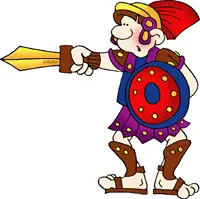Mosaic Floors
Just like their counterparts in ancient Greece, the ancient Romans loved their art. The ancient Romans perfected mosaic artwork.
In ancient Rome mosaic artwork was found everywhere but the most common use of mosaic artwork was mosaic floors. The intricate mosaic floors were found in palaces, wealthy homes, bathhouses, and even sidewalks.
The ancient mosaic floors in Rome told stories about several items like religion, everyday life, gods, and warfare.
How did they make ancient Roman mosaic floors?
Ancient Roman mosaic floors were created by craftsmen. Their work was not signed like artists. There were special schools to teach a craftsman how to make a mosaic floor.
The mosaic floors had a base layer of straw or wood. Then the craftsman would put layer of mortar which is like cement. The next step would be to draw the picture or design on the mortar.
The craftsman then placed tiny pieces of glass, stones, or ceramic to from the design or picture. The tiny pieces of material used were called tesserae.
Why were mosaic floors important?
Ancient Roman mosaic floors were important for many reasons. Mosaic floors were practical and could be cleaned easily. The mosaic floors also kept the houses, palaces, and government buildings cool in the warm climate of ancient Rome.
Mosaic floors also reflected light which made the interior of a building bright. Another reason the ancient Roman built mosaic floors is that the floors were water proof and great for bathhouses.
Mosaic floors were also a symbol for the wealthy. The wealthier a family or person was enabled them to hire craftsmen to construct the mosaic floors.
The more complicated the design of the mosaic floor also symbolized the wealth of a family or individual.
What were the most common designs of ancient Roman mosaic floors?
Craftsmen created thousands of different mosaic floors in ancient Rome. Designs varied from household to household and buildings to buildings.
Some of the most common designs were of ancient Roman gods or mythical figures. Gladiators were also used in the design of mosaic floors. Other designs included romantic scenes, various animals, and warriors battling.
Some mosaic floors were dedicated to specific battles fought by ancient Roman soldiers.
Ancient Roman mosaic floors were also used for advertising. These mosaic designs usually are found on walls of buildings or on sidewalks were there was heavy pedestrian use of the walkway.
Best examples of ancient Roman mosaic floors
The Romans occupied many places during their time as the world leader. Mosaic floors are found in the Middle East, throughout Europe, and North Africa.
Some of the best preserved mosaic floors are in the city of Pompeii. The city was destroyed when Mount Vesuvius exploded and covered the city in ash and lava.
The volcanic ash helped to preserve the intricate mosaic floors. Other places in the world with extensive collections are the British Museum in London and the Roman Museum in the city of Cirencester in England that was once a prominent Roman outpost.
Facts about ancient Roman mosaic floors
- Ancient Roman mosaic floors were created by craftsmen and not by artists. The mosaic floors were never signed by the craftsmen.
- There were schools that taught craftsmen how to construct mosaic floors.
- Mosaic floors were a sign of wealth and were found in homes, government buildings, sidewalks, and bathhouses. Occasionally mosaic floors are found on walls and the side of buildings.
- The craftsmen used mortar which is a form of cement to hold the thousands of tiny pieces of glass, stone, and ceramics which were called tesserae.
- Design of the mosaic floors were battle scenes, animals, Roman gods, mythological figures, and important Roman people. Sometimes mosaic floors were used for advertising too.
- Mosaic floors were durable and waterproof. The floors helped brighten living spaces within a home or building and were easily cleaned.
- Mosaic floors are found in all of the former areas which were occupied by the ancient Romans including Europe, the Middle East, and North Africa.
- The best preserved mosaic floors are found in the ancient city of Pompeii. The mosaic floors were preserved by the volcanic ash when Mount Vesuvius exploded.
What did you learn?
- Who constructed the ancient Roman mosaic floors?
Craftsmen
- What was the name of the tiny pieces of glass, ceramics, and stones used to make the mosaic floors?
Tesserae
- Where are the best preserved mosaic floors?
Pompeii
- What type of home were mosaic floors more common?
Wealthier homes
- Besides being durable and waterproof, mosaic floors were desirable for what other thing?
Easily cleaned



